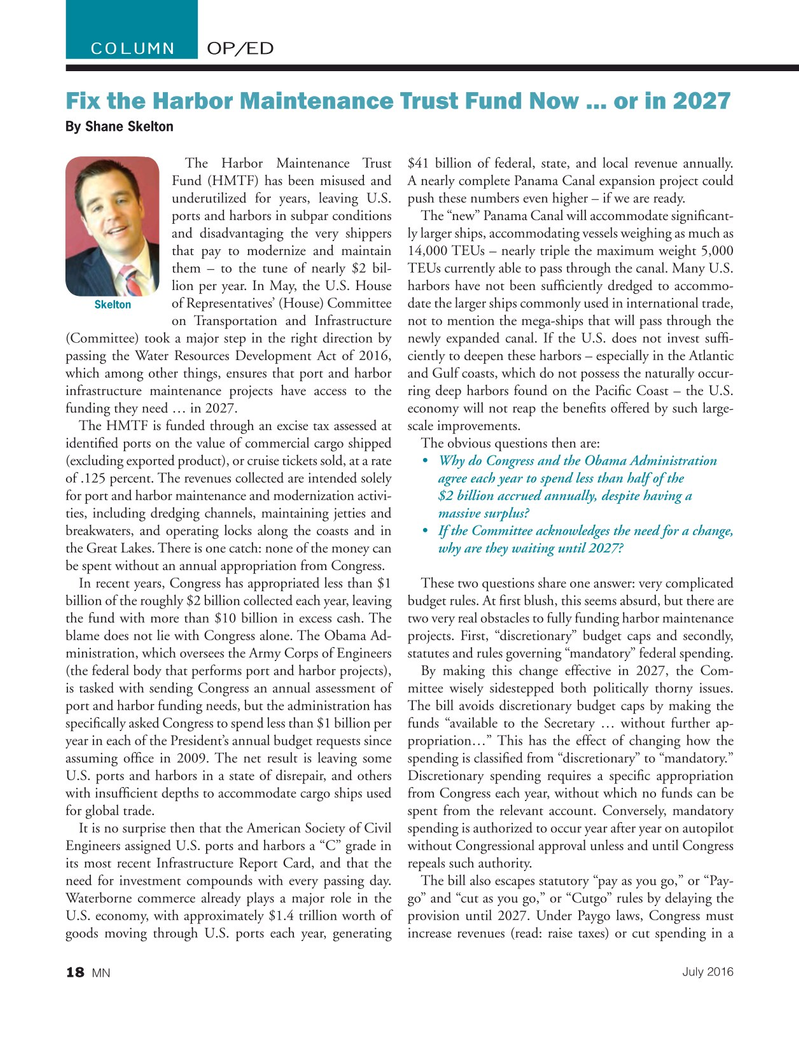
Page 18: of Marine News Magazine (July 2016)
Propulsion Technology
Read this page in Pdf, Flash or Html5 edition of July 2016 Marine News Magazine
COLUMN OP/ED
Fix the Harbor Maintenance Trust Fund Now … or in 2027
By Shane Skelton
The Harbor Maintenance Trust $41 billion of federal, state, and local revenue annually.
Fund (HMTF) has been misused and A nearly complete Panama Canal expansion project could underutilized for years, leaving U.S. push these numbers even higher – if we are ready. ports and harbors in subpar conditions The “new” Panama Canal will accommodate signi? cant- and disadvantaging the very shippers ly larger ships, accommodating vessels weighing as much as that pay to modernize and maintain 14,000 TEUs – nearly triple the maximum weight 5,000 them – to the tune of nearly $2 bil- TEUs currently able to pass through the canal. Many U.S. lion per year. In May, the U.S. House harbors have not been suf? ciently dredged to accommo- of Representatives’ (House) Committee date the larger ships commonly used in international trade,
Skelton on Transportation and Infrastructure not to mention the mega-ships that will pass through the (Committee) took a major step in the right direction by newly expanded canal. If the U.S. does not invest suf? - passing the Water Resources Development Act of 2016, ciently to deepen these harbors – especially in the Atlantic which among other things, ensures that port and harbor and Gulf coasts, which do not possess the naturally occur- infrastructure maintenance projects have access to the ring deep harbors found on the Paci? c Coast – the U.S. funding they need … in 2027. economy will not reap the bene? ts offered by such large-
The HMTF is funded through an excise tax assessed at scale improvements.
identi? ed ports on the value of commercial cargo shipped The obvious questions then are: (excluding exported product), or cruise tickets sold, at a rate • Why do Congress and the Obama Administration of .125 percent. The revenues collected are intended solely agree each year to spend less than half of the for port and harbor maintenance and modernization activi- $2 billion accrued annually, despite having a ties, including dredging channels, maintaining jetties and massive surplus? breakwaters, and operating locks along the coasts and in • If the Committee acknowledges the need for a change, the Great Lakes. There is one catch: none of the money can why are they waiting until 2027?
be spent without an annual appropriation from Congress.
In recent years, Congress has appropriated less than $1 These two questions share one answer: very complicated billion of the roughly $2 billion collected each year, leaving budget rules. At ? rst blush, this seems absurd, but there are the fund with more than $10 billion in excess cash. The two very real obstacles to fully funding harbor maintenance blame does not lie with Congress alone. The Obama Ad- projects. First, “discretionary” budget caps and secondly, ministration, which oversees the Army Corps of Engineers statutes and rules governing “mandatory” federal spending.
(the federal body that performs port and harbor projects), By making this change effective in 2027, the Com- is tasked with sending Congress an annual assessment of mittee wisely sidestepped both politically thorny issues. port and harbor funding needs, but the administration has The bill avoids discretionary budget caps by making the speci? cally asked Congress to spend less than $1 billion per funds “available to the Secretary … without further ap- year in each of the President’s annual budget requests since propriation…” This has the effect of changing how the assuming of? ce in 2009. The net result is leaving some spending is classi? ed from “discretionary” to “mandatory.”
U.S. ports and harbors in a state of disrepair, and others Discretionary spending requires a speci? c appropriation with insuf? cient depths to accommodate cargo ships used from Congress each year, without which no funds can be for global trade. spent from the relevant account. Conversely, mandatory
It is no surprise then that the American Society of Civil spending is authorized to occur year after year on autopilot
Engineers assigned U.S. ports and harbors a “C” grade in without Congressional approval unless and until Congress its most recent Infrastructure Report Card, and that the repeals such authority.
need for investment compounds with every passing day. The bill also escapes statutory “pay as you go,” or “Pay-
Waterborne commerce already plays a major role in the go” and “cut as you go,” or “Cutgo” rules by delaying the
U.S. economy, with approximately $1.4 trillion worth of provision until 2027. Under Paygo laws, Congress must goods moving through U.S. ports each year, generating increase revenues (read: raise taxes) or cut spending in a
July 2016
MN 18
MN July16 Layout 18-31.indd 18 6/20/2016 3:41:12 PM

 17
17

 19
19
